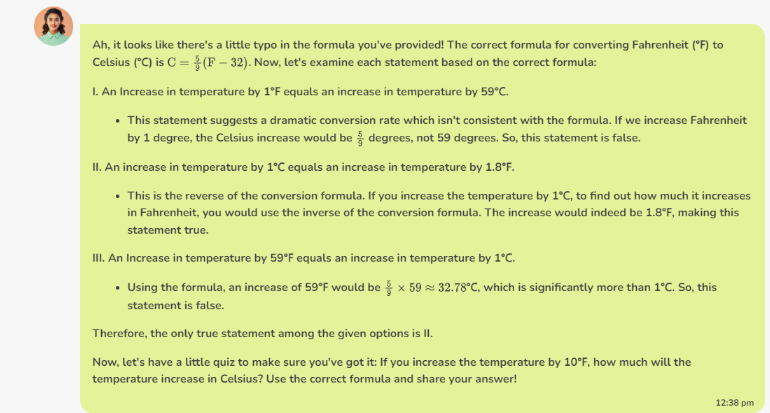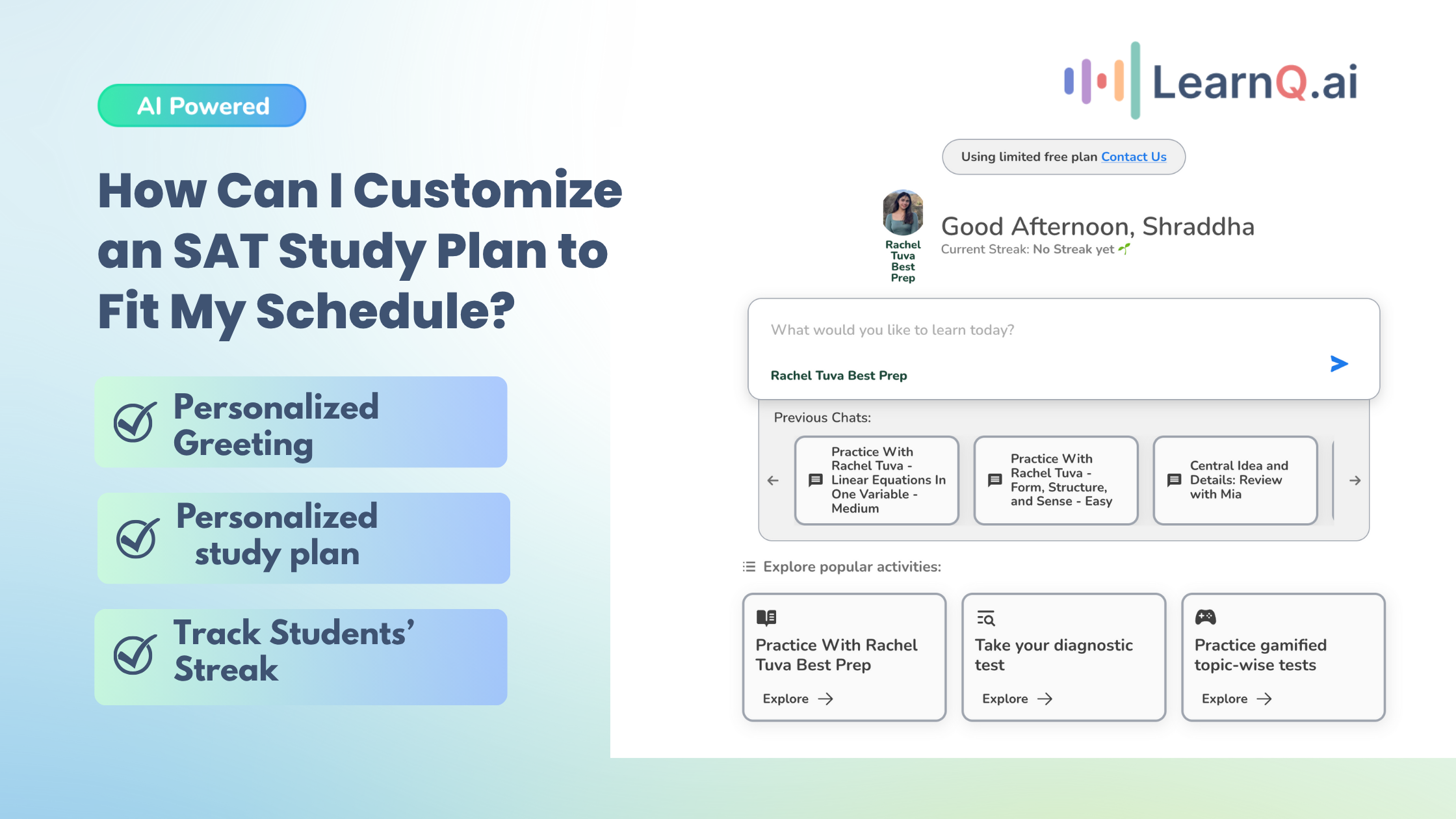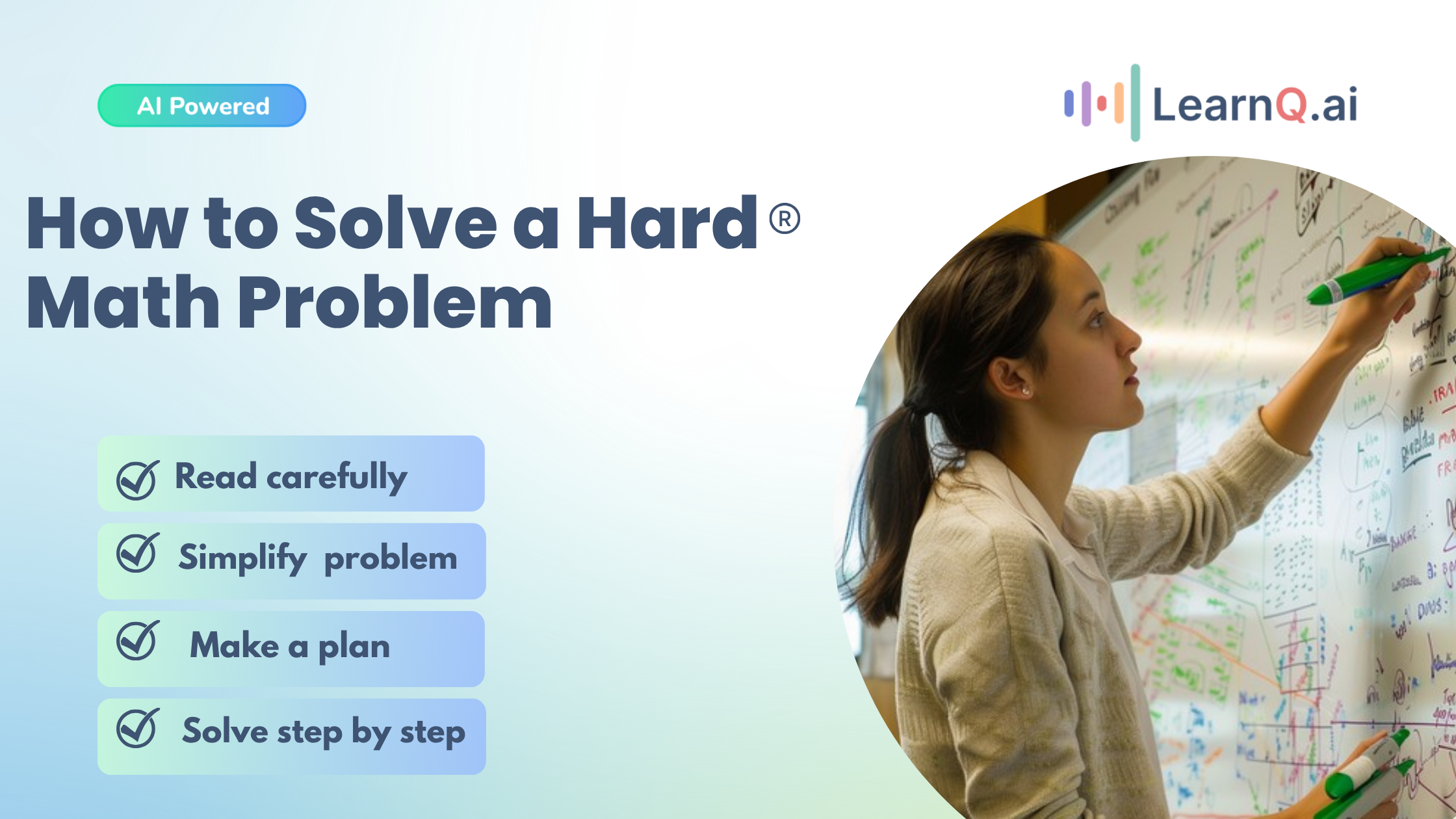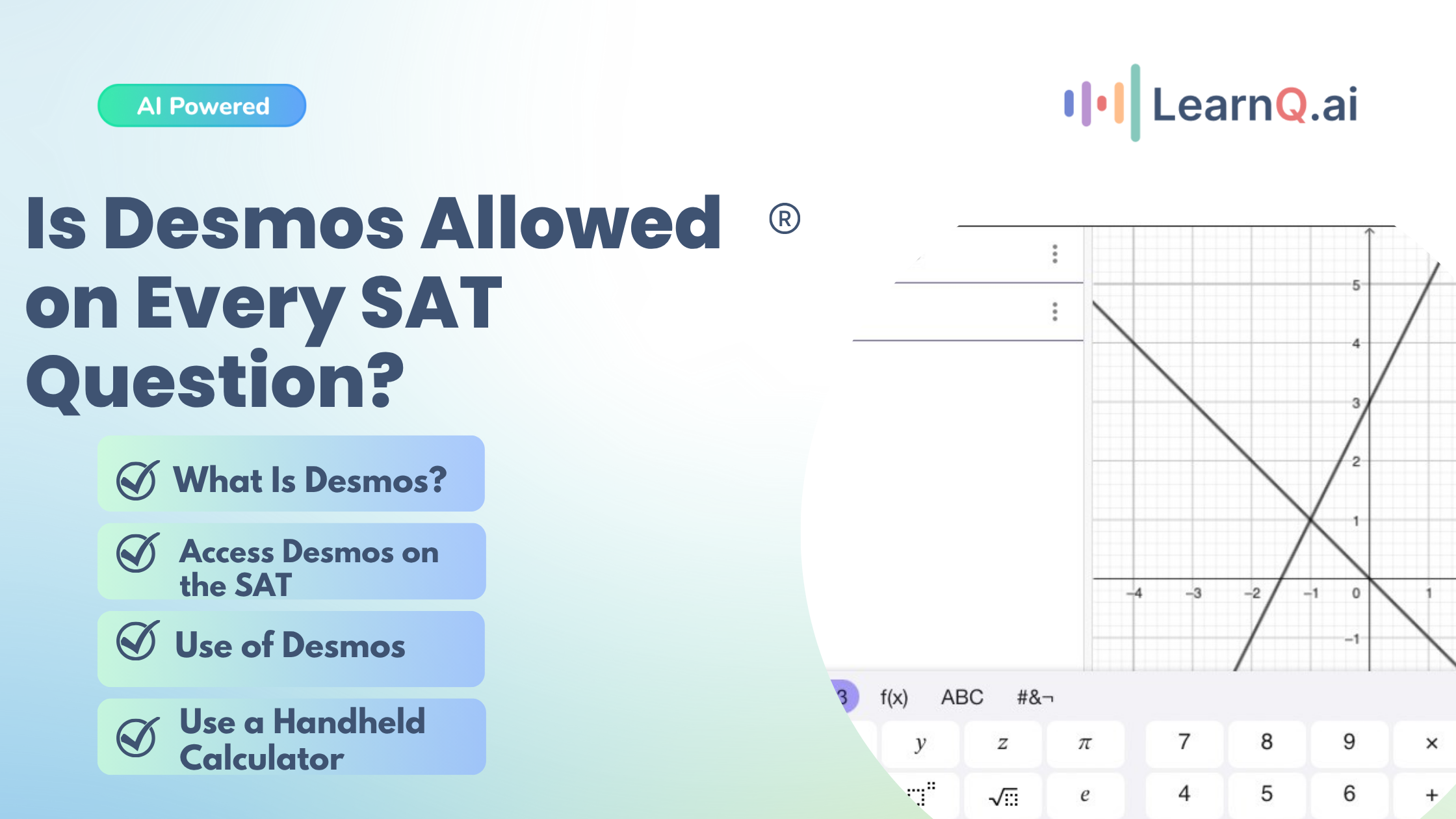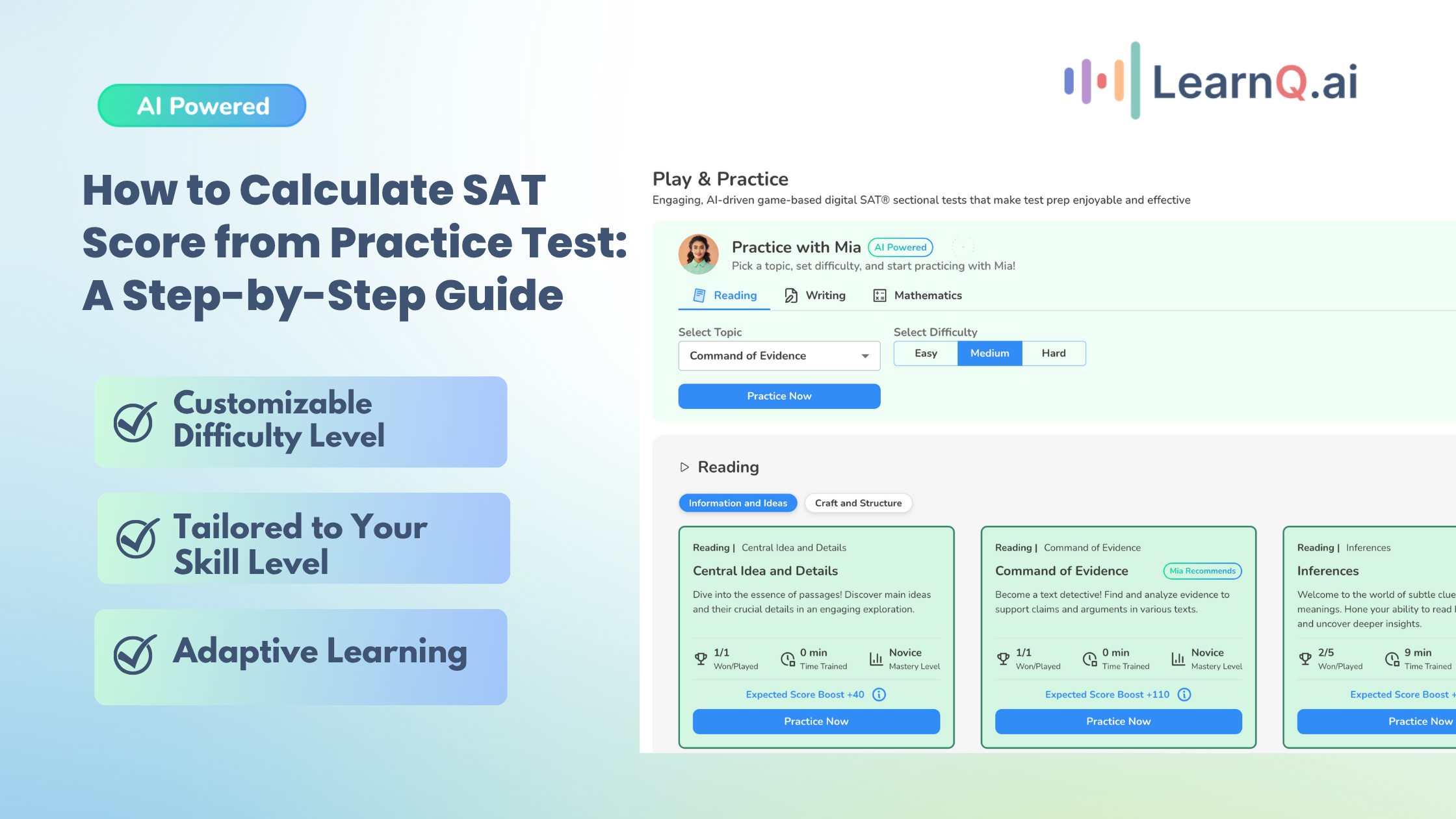Some of the most missed SAT Math questions are also particularly challenging when you consider the Digital SAT Math section. These questions involve complex concepts, multi-step problem-solving, or unfamiliar mathematical principles. Understanding these questions’ intricacies will help you strategize your preparation more effectively.
Consider leveraging AI-driven tools like LearnQ.ai for a more personalized and efficient study plan. This blog aims to highlight such challenging areas, provide examples, and offer strategies for mastering them.
Overview of Digital SAT Math Paper
The digital SAT Math section is composed of 44 questions, split into 33 MCQs and 11 student-generated questions. The question distribution is as follows:
Category | Description | Percentage of Test |
Heart of Algebra | Linear equations and inequalities, their graphs, and systems | 33% |
Problem Solving and Data Analysis | Ratios, proportions, percentages, units, analyzing graphical data, probabilities, and statistics | 29% |
Passport to Advanced Math | Identifying and creating equivalent expressions, quadratic and nonlinear equations/functions, and graphs | 28% |
Additional Topics in Math | Geometry, trigonometry, radians, the unit circle, and complex numbers | 10% |
Detailed Analysis of Selected Hard Questions
This section delves into a detailed analysis of the most missed SAT Math questions. Examining these tricky problems will give you insights into common pitfalls, and you can learn effective strategies to tackle them.
1. Temperature Conversion
Temperature conversion questions often go beyond straightforward calculations. They may require you to convert between Fahrenheit, Celsius, or Kelvin and involve complex algebraic manipulation.
Question
LearnQ.ai is Powered by VEGA AI—Is your Institute Next?
Give students a Duolingo-style test-prep platform with Shopify-level customization for tutors and institutes.
2. Exponential Expression Evaluation
Exponential expressions can be complex, especially when involving different bases or requiring simplification through logarithms. LearnQ.ai’s diagnostic tests can help identify areas where you might need additional practice.
3. Circle and Arc Length
Finding the arc length involves understanding both geometric and algebraic principles. You need to be adept at using the formula 𝐿=𝑟𝜃 (where 𝐿 is the arc length, r is the radius, and 𝜃 is the central angle in radians).
Question: Points A and B lie on a circle with a radius of 1, and arc AB has a length of 𝜋/3. What fraction of the circle’s circumference is the length of arc AB?
Question
Question: Points A and B lie on a circle with a radius of 1, and arc AB has a length of 𝜋3. What fraction of the circle’s circumference is the length of arc AB?
Solution: Circumference of the circle, C=2𝜋r
C=2𝜋 (1)
C=2𝜋
Suppose arc AB is an ‘f’ fraction of the circumference.
f=𝜋3/2𝜋
f=16
4. Algebra
Question
Store A sells raspberries for $5.50 per pint and blackberries for $3.00 per pint. Store B sells raspberries for $6.50 per pint and blackberries for $8.00 per pint. A certain purchase of raspberries and blackberries would cost $37.00 at store A or $66.00 at store B. How many pints of blackberries are in this purchase?
5. Trigonometry in Geometry
Trigonometric problems often require you to apply identities and understand their geometric implications.
Question
In triangle 𝐴𝐵𝐶, the measure of ∠𝐵 is 90°, 𝐵𝐶=16, and 𝐴𝐶=20. Triangle 𝐷𝐸𝐹 is similar to triangle 𝐴𝐵𝐶, where vertices 𝐷, 𝐸, and 𝐹 correspond to vertices 𝐴, 𝐵, and 𝐶, respectively, and each side of triangle 𝐷𝐸𝐹 is 13 the length of the corresponding side of triangle 𝐴𝐵𝐶. What is the value of 𝑠𝑖𝑛𝐹?
Solution:
If you are stuck somewhere while practicing, using LearnQ.ai’s AI Tutor, Ask MIA, you can get real-time help and insights into solving such multifaceted problems.
Enhance your Digital SAT study routine with AI-driven insights and personalized practice tests.
6. Volume
The question given below is considered one of the most important and hardest SAT Math questions.
Question
A grain silo is constructed using two right circular cones and a right circular cylinder. The internal dimensions of the silo are shown in the figure above. Find the best approximation of the volume of the grain silo in cubic feet.
Solution:
7. Percentages
Question
In a group, 40% of the items are red. Of all the red items in the group, 30% also have stripes. What percentage of the items in the group are red and have stripes?
Solution

8. Linear Functions
Question
If f(x) = x + 7 and g(x) = 7x, what is the value of 4f(2) − g(2)?
What do the Hardest SAT Math Questions Have in Common, and What are Some Ways to Tackle Them
Understanding the traits of the hardest SAT math questions helps develop effective strategies for tackling them. These questions often combine multiple concepts, require multi-step problem-solving, and include less familiar mathematical ideas or unusual structures.
Combination of Multiple Concepts in a Single Question: These questions often integrate various areas of math, such as algebra, geometry, and trigonometry, requiring a comprehensive understanding to solve them.
Tip: Practice problems combining different mathematical concepts to build your ability to navigate these complex questions. Platforms like LearnQ.ai allow you to tailor your practice to cover multiple concepts in one go.
Requirement for Multi-Step Problem-Solving Approaches: The hardest questions often involve several steps to arrive at the correct answer.
Tip: Break down each problem into smaller, manageable parts and solve them sequentially to avoid feeling overwhelmed.
Use of Less Familiar Mathematical Concepts or Unusual Problem Structures: Some questions may introduce concepts that are not commonly encountered in regular practice.
Tip: Familiarize yourself with various mathematical principles and practice solving unconventional problems to build confidence and adaptability.
Incorporation of Real-World Scenarios: These questions often involve applying mathematical concepts to real-world situations, making them more complex and nuanced.
Tip: Practice word problems and real-world applications to get comfortable translating verbal descriptions into mathematical equations.
Complex Diagrams and Graphs: Interpreting complex diagrams or graphs can add another layer of difficulty to SAT math questions.
Tip: Improve your skills in reading and interpreting graphs and diagrams through regular practice and review.
Tricky Wording and Phrasing: How a question is worded can sometimes make it more difficult to understand and solve.
Tip: Read each question carefully and make sure you understand what is being asked before attempting to solve it. Practice paraphrasing questions in simpler terms.
Time-Consuming Calculations: Some questions may require lengthy calculations, making time management crucial.
Tip: Practice efficient calculation techniques and consider whether using a calculator might save time for specific problems.
Higher-Order Thinking: The hardest questions often require deeper analysis and critical thinking.
Tip: Engage in exercises that promote higher-order thinking and challenge you to think critically about mathematical problems.
LearnQ.ai is powered by VEGA AI—Is your institute next?
Offer students a Duolingo-style test-prep platform with Shopify-level customization for tutors and institutes.






Conclusion
Difficult math questions play a crucial role in the SAT’s assessment of your capabilities. Preparing for these challenges boosts your confidence and scores. Embrace the difficulty as part of your learning process. You’ll improve your SAT performance and enhance your overall mathematical proficiency and resilience by tackling the most missed SAT math questions head-on.
Start your journey today with LearnQ.ai, and watch yourself grow into a more confident and capable student.


